#hendrik sartov
Photo

Cinematographer Hendrik Sartov, director King Vidor, producer Irving Thalberg (MGM) and Lillian Gish behind the scenes of ''La Boheme'' 1926
3 notes
·
View notes
Text
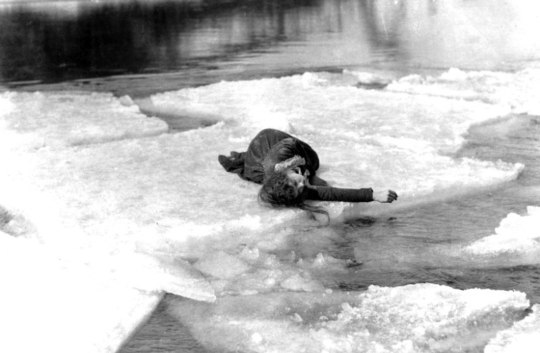
Lillian Gish in Way Down East (D.W. Griffith, 1920)
Cast: Lillian Gish, Richard Barthelmess, Mrs. David Landau, Lowell Sherman, Burr McIntosh, George Neville, Edgar Nelson. Screenplay: Anthony Paul Kelly, based on a play by Lottie Blair Parker. Cinematography: G.W. Bitzer, Paul H. Allen, Charles Downs, Hendrik Sartov. Art direction: Clifford Pember, Charles O. Seessel. Film editing: James Smith, Rose Smith.
If Griffith's sententious title cards (e.g.,"Not by laws -- our Statutes are now overburdened by ignored laws -- but within the heart of man, the truth must bloom that his greatest happiness lies in his purity and constancy") don't have some viewers reaching for the remote, then the cornpone comic antics of his stereotypical rustics, such as the toothless constable (George Neville) and the hayseed Hi Holler (Edgar Nelson), certainly will. But stick with it to witness one of the greatest action sequences on film, Anna (Lillian Gish) adrift on the ice floe, as well as one of Gish's greatest moments as an actress, when she baptizes her dying baby. Yes, it's all hokum -- what do you expect from a melodrama more than a century old? But it's magnificent, enduring hokum, done brilliantly by a director who now seems more than just a pioneer but an artist of stature. And yes, that stature is tarnished by the man's racism in The Birth of a Nation (1915), but we don't have to endorse our artists to appreciate their artistry, and the great efficiency with which Griffith tells a story and keeps us on the edge of our seats -- even when we know that his sentimentality is antique and outworn -- is something to be appreciated. Credit, too, must go to G.W. Bitzer (known as Billy) and the other cinematographers (Paul H. Allen, Charles Downs, and Hendrik Sartov) who gave us images that seem well advanced beyond the years in which they were filmed. I do admit to some surprise that there are so many scenes in Way Down East that Griffith is content to film as if they were happening on a proscenium stage when one of his great contributions to the art of cinema is providing a fluidity and intimacy that are unavailable in the theater. Perhaps he was trying to do justice to his set designers, Clifford Pember and Charles O. Seessel, whose work is quite spectacular. But nothing before or since has quite equaled the ice floe sequence.
4 notes
·
View notes
Link
0 notes
Photo
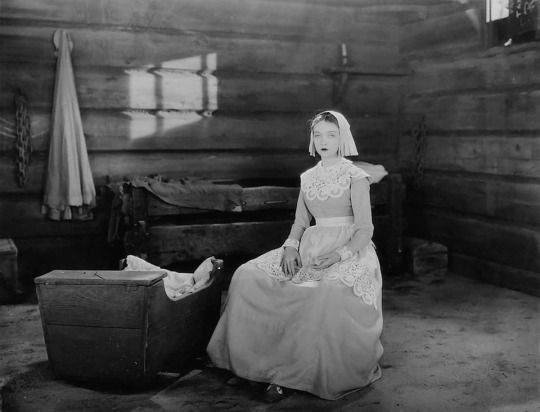
“The Scarlet Letter”, 1927.
Lillian Gish as Hester Prynne.
Directed by Victor Sjöström.
Cinematography: Hendrik Sartov.
Metro-Goldwyn-Mayer
#lillian gish#victor sjöström#hendrik sartov#metro-goldwyn-mayer#habitantes-oazj#film#the scarlet letter
2 notes
·
View notes
Photo
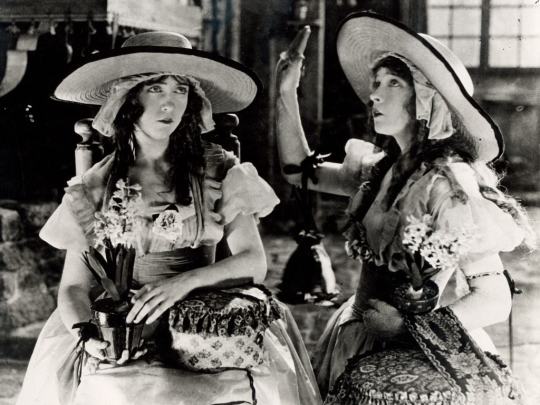
Dorothy Gish and Lillian Gish in Orphans of the Storm (D.W. Griffith, 1921)
Cast: Lillian Gish, Dorothy Gish, Joseph Schildkraut, Frank Losee, Katherine Emmet, Morgan Wallace, Lucille La Verne, Sheldon Lewis, Frank Puglia, Creighton Hale, Monte Blue, Sidney Herbert. Screenplay: D.W. Griffith, based on a novel by Adolphe d’Ennery and Eugène Cormon. Cinematography: Paul H. Allen, G.W. Bitzer, Hendrik Sartov. Art direction: Charles M. Kirk. Film editing: James Smith, Rose Smith.
Who knew that one of the chief causes of the French Revolution's Reign of Terror was "Bolshevism"? Or that Danton, who helped send Louis XVI to the guillotine, was "the Abraham Lincoln of France," as one of the title cards for Orphans of the Storm proclaims? D.W. Griffith's gift for pseudo-historical hokum stood him in good stead in making this often preposterous classic, but it worked even better for Lillian and Dorothy Gish, whose performances as the titular orphans are superb. I think Dorothy may give the better performance as Louise, the foundling who is left blind by the "plague" that killed her adoptive parents, but that may be because I've seen Lillian's winsome tricks more often than Dorothy's. Lillian certainly flings herself into the role of Henriette, who became Louise's sister after her parents took in the girl as an infant, and her caretaker after she became blind. The girls go to Paris in search of a cure for Louise's blindness, and there Henriette is abducted by a lecherous aristocrat but saved by the virtuous Chevalier de Vaudrey (a surprisingly handsome young Joseph Schildkraut). Separated from Henriette, Louise falls into the clutches of the conniving Mother Frochard (Lucille La Verne), who puts the blind girl to work begging on the streets. (La Verne sports a monstrous wen and a mustache, reminding us that she was the voice of the wicked queen and the witch in the 1937 Disney Snow White and the Seven Dwarfs.) And then comes the Revolution, in which Henriette almost loses her head to the guillotine, thanks to the evil Robespierre (Sidney Herbert), before being rescued by, of all people, Danton (Monte Blue). (An end title informs us that the Reign of Terror ceased when Robespierre was beheaded, but conveniently ignores the similar fate of Danton.) In the end, Henriette and de Vaudrey are to be married, and Louise not only regains her sight but also learns that she was the daughter of the Countess de Linieres (Katherine Emmet) from a previous marriage to a commoner that was suppressed by the countess's family. This delicious stuff, which Griffith's screenplay took from a novel by Adolphe d'Ennery and Eugène Cormon along with liberal borrowings from Dumas, Dickens, and Victor Hugo, is kept furiously aboil by Griffith's superb gift for pacing and cutting. He never lets the action flag, even for the necessary exposition.
5 notes
·
View notes
Photo

Marion Davies and Owen Moore in The Red Mill (Roscoe Arbuckle, 1927)
Cast: Marion Davies, Owen Moore, Louise Fazenda, George Siegmann, Karl Dane, Russ Powell, Snitz Edwards, William Orlamond, Ignatz. Screenplay: Frances Marion, titles by Joseph Farnham, based on a musical by Victor Herbert and Henry Martyn Blossom. Cinematography: Hendrik Sartov. Art direction: Cedric Gibbons, Merrill Pye. Film editing: Daniel J. Gray. Music: Michael Picton.
The Red Mill was directed by Roscoe ("Fatty") Arbuckle under the pseudonym “William Goodrich” that he adopted after being blacklisted in the "wild party” scandal over the death of Virginia Rappe, even though he was acquitted. It's a fairly forgettable romantic farce, about Tina (Marion Davies), a Dutch scullery maid, who falls in love with Dennis (Owen Moore), an Irishman visiting Holland, and gets involved with a plot to save Gretchen (Louise Fazenda) from having to marry someone other than her boyfriend Jacop (Karl Dane). Very loosely based on a creaky old Victor Herbert operetta, it's a surprisingly well-preserved silent film, with crisp images -- the cinematography is by Hendrik Sartov, a Danish director of photography who also shot the Lillian Gish films La Bohème (King Vidor, 1926) and The Scarlet Letter (Victor Sjöstrom, 1926). Given that it's a fitfully amusing comedy, whose chief virtue is that is shows off the great comic gifts of Davies, it might be surprising to find it in such pristine condition when so many other (and better) silent films are available only in patched-together restorations or have been lost altogether. The reason is probably that it was produced by William Randolph Hearst's company, Cosmopolitan Productions, which existed largely to showcase Davies, Hearst's mistress. So MGM, which released the film, took special care not to offend Hearst in its handling of The Red Mill. Davies is, as so frequently, a delight, playing physical comedy without sacrificing her beauty and femininity. She does a wonderful slapstick bit in which she tries to solve the problem of assembling a folding ironing board -- a twist on the familiar struggles of comedians with folding beach chairs. But Arbuckle, who directed dozens of short films, doesn't give this movie the pace needed to sustain itself at feature length. Joseph Farnham is responsible for the cornball captions -- sample: "A summer on Holland's canals leaves an impression, but a fall on its ice leaves a scar."
1 note
·
View note
Link
Extraordinarily concentrated, Broken Blossoms is at its best deeply moving: the sequence in which her father drags Lucy from her hiding place and she pleads for mercy before he strikes her down is, due to the dynamic editing and Miss Gish’s playing, made a piercingly lifelike visual experience. The last sequence shows Griffith’s new mastery of suspense—the Yellow Man picking up a knife to stab himself to death following his murder of Lucy’s father; the police breaking in; then a shot of a man striking a gong, and ships sailing out toward the Thames basin. A short textbook of editing in itself, it is a sequence that rewards many reviewings. Photographed under the supervision of Hendrik Sartov by Billy Bitzer, the film offers consistently rewarding images, its evocation of misty streets, piers gleaming, the tracery of rigging on a skyline, cramped lodginghouse rooms foreshadowing and superior to von Sternberg’s The Docks of New York.
1 note
·
View note
Photo
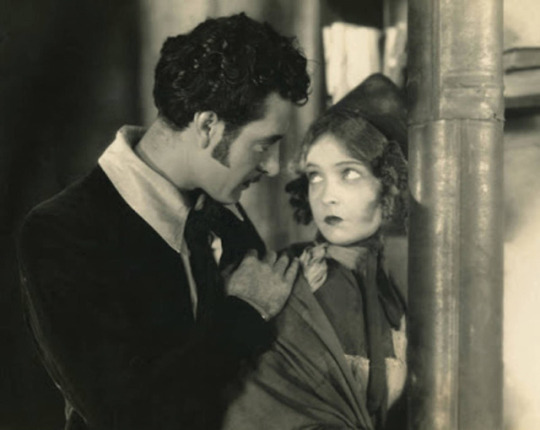

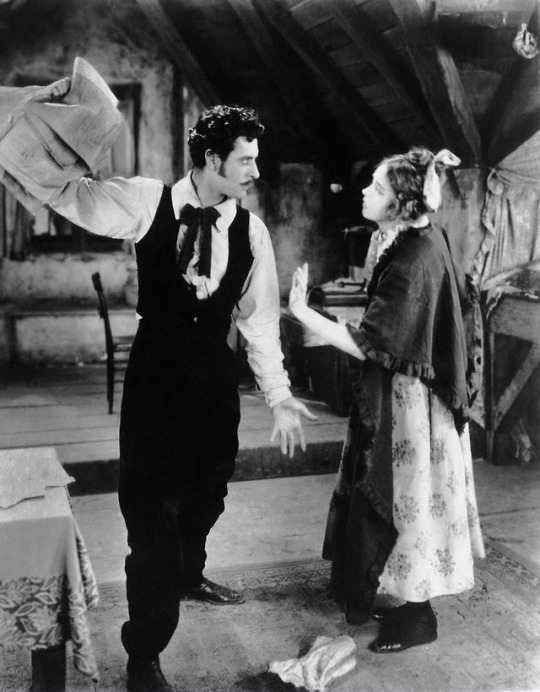
La Bohčme (1926)
Director: King Vidor Writers: Fred De Gresac (screen play) Henri Murger (suggested by "Life in the Latin Quarter") 13 March 1926 (USA) In 1925 Lillian Gish signed a contract with Metro-Goldwyn-Mayer: six pictures in two years for which she would be paid one million dollars. She was given complete control over director, story and cast. Miss Gish was the first established movie star to be signed by the studio. As she walked on the studio lot for the first time, banners festooned the place proclaiming that Lillian Gish was now an MGM star! Unfortunately though, no one seemed prepared for her arrival. There were no scripts for her to look at, no story outlines, not even any ideas about what her first project for the studio might be. Miss Gish relates, “So I brought out my little chest of stories, among which was La Bohčme.” The studio approved. Irving Thalberg then asked Miss Gish whom she would like as her director. As she had been in Italy for two years, she had seen few recent films. Thalberg screened several for her including two reels of the yet uncompleted The Big Parade. She was so smitten with what she saw she requested the services of that film’s director, King Vidor, as well as star John Gilbert, leading lady Renée Adorée, and comic sidekick Karl Dane. She also asked for and got Hendrik Sartov as her cinematographer. Sartov had shot some of Gish’s later films for director D.W. Griffith including Orphans of the Storm (1921) and parts of Way Down East (1920). After a rehearsal period (something unheard of in studio film making of the day but part of Miss Gish’s contract) production began Artists struggle to survive in Paris, and a poor woman sacrifices herself to help a young playwright. This romantic drama reflects the sacrifice a woman often makes to help the career of a young man she loves. In modern civilization the quest to achieve success in the arts often requires years of personal sacrifices. John Gilbert was infatuated with Lillian Gish, and would mess up his "love scenes" with her on purpose, so he could keep kissing her.
2 notes
·
View notes
Photo
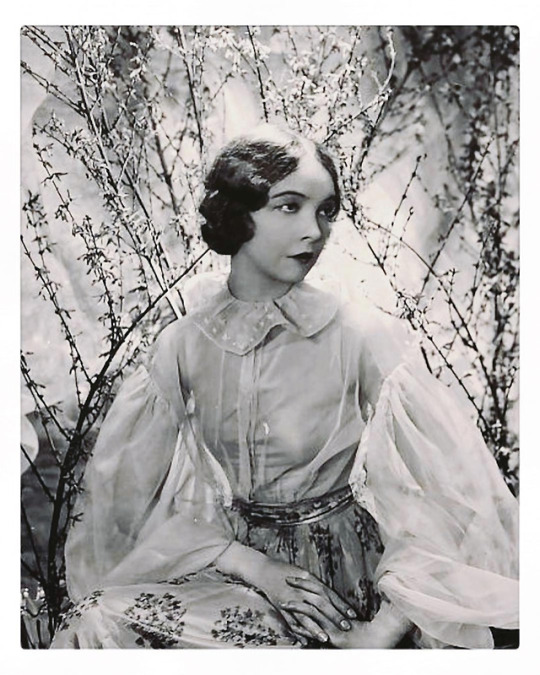
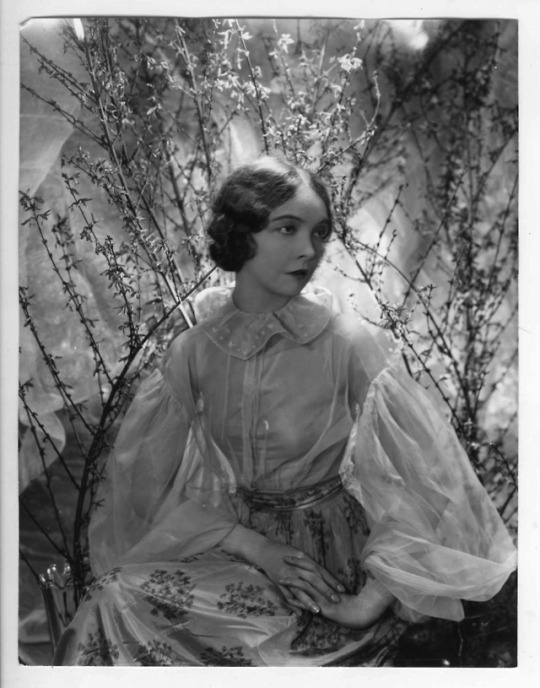
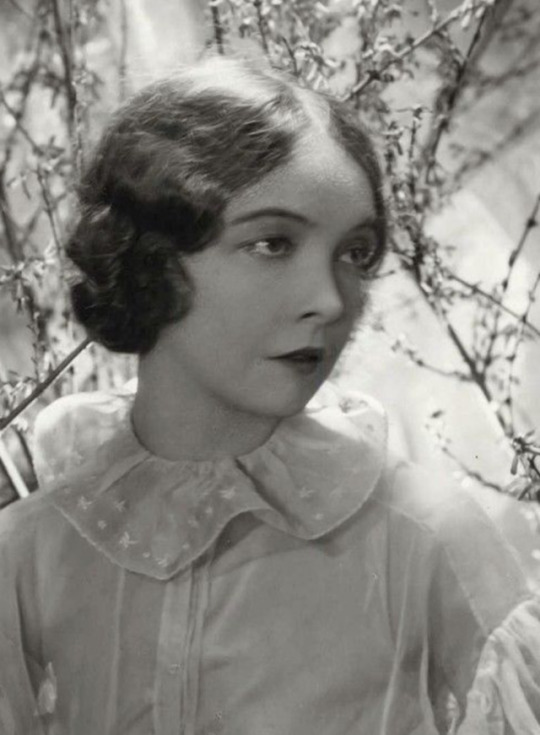
Lillian Gish - La Bohème (1926) promotional - Svenska Dagbladets Bild Arkiv
La Bohème (1926) - Director: King Vidor Writers: Fred De Gresac (screen play) Henri Murger (suggested by "Life in the Latin Quarter") 13 March 1926 (USA) In 1925 Lillian Gish signed a contract with Metro-Goldwyn-Mayer: six pictures in two years for which she would be paid one million dollars. She was given complete control over director, story and cast. Miss Gish was the first established movie star to be signed by the studio. As she walked on the studio lot for the first time, banners festooned the place proclaiming that Lillian Gish was now an MGM star! Unfortunately though, no one seemed prepared for her arrival. There were no scripts for her to look at, no story outlines, not even any ideas about what her first project for the studio might be. Miss Gish relates, “So I brought out my little chest of stories, among which was La Bohème.” The studio approved. Irving Thalberg then asked Miss Gish whom she would like as her director. As she had been in Italy for two years, she had seen few recent films. Thalberg screened several for her including two reels of the yet uncompleted The Big Parade. She was so smitten with what she saw she requested the services of that film’s director, King Vidor, as well as star John Gilbert, leading lady Renée Adorée, and comic sidekick Karl Dane. She also asked for and got Hendrik Sartov as her cinematographer. Sartov had shot some of Gish’s later films for director D.W. Griffith including Orphans of the Storm (1921) and parts of Way Down East (1920). After a rehearsal period (something unheard of in studio film making of the day but part of Miss Gish’s contract) production began Artists struggle to survive in Paris, and a poor woman sacrifices herself to help a young playwright. This romantic drama reflects the sacrifice a woman often makes to help the career of a young man she loves. In modern civilization the quest to achieve success in the arts often requires years of personal sacrifices. John Gilbert was infatuated with Lillian Gish, and would mess up his "love scenes" with her on purpose, so he could keep kissing her.
5 notes
·
View notes
Link
Seastrom’s American career can be considered a success. The Scarlet Letter ( 1926 ) was undoubtedly his masterpiece, an adaptation of the Hawthorne novel, in which the stark, puritanical fervor of the original novel was matched by the austere echoes of Scandinavian cinema. Even though the scenario somewhat muted and romanticized Hawthorne’s original, Lars Hanson’s extremely stylized playing and Hendrik Sartov’s superb camerawork, full of delicate pictorial symbolism, restored the balance. Lillian Gish’s mature and sensitive performance, in a role that was a far cry from the Victorian innocents that she had played for Griffith, was superb.
0 notes